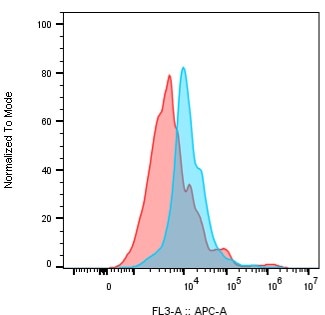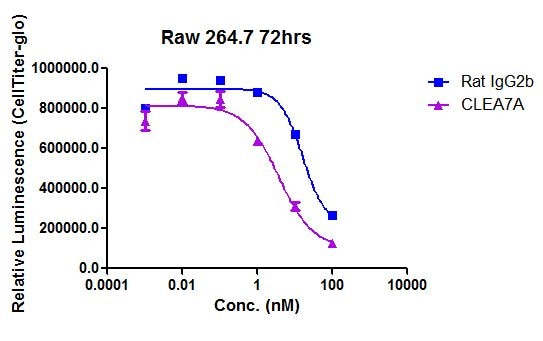Mouse Dectin-1/CLEC7A Antibody Summary
Phe69-Leu244
Accession # Q6QLQ4
*Small pack size (-SP) is supplied either lyophilized or as a 0.2 µm filtered solution in PBS.
Applications
Please Note: Optimal dilutions should be determined by each laboratory for each application. General Protocols are available in the Technical Information section on our website.
Scientific Data
 View Larger
View Larger
Detection of Dectin‑1/CLEC7A in Raw264.7 Mouse Cell Line by Flow Cytometry. Mouse Raw264.7 monocyte/macrophage cell line was stained with Rat Anti-Mouse Dectin-1/CLEC7A Monoclonal Antibody (Catalog # MAB17561, filled histogram) or Rat IgG2A Isotype Control (MAB006, open histogram) followed by PE-conjugated anti-Rat IgG Secondary Antibody (F0105B). Staining was performed using our Staining Membrane-associated Proteins protocol.
Reconstitution Calculator
Preparation and Storage
- 12 months from date of receipt, -20 to -70 °C as supplied.
- 1 month, 2 to 8 °C under sterile conditions after reconstitution.
- 6 months, -20 to -70 °C under sterile conditions after reconstitution.
Background: Dectin-1/CLEC7A
Dectin-1, also known as CLEC7A and the beta -glucan receptor, is a 43 kDa type II transmembrane C-type lectin that functions in the innate immune response to fungal pathogens. Although Dectin-1 resembles other CLEC molecules structurally, it binds ligands in a calcium-independent manner (1, 2). Mature mouse Dectin-1 is a 244 amino acid (aa) glycoprotein that consists of a short ITAM-containing cytoplasmic tail, a transmembrane segment, and a stalk and carbohydrate recognition domain (CRD) in the extracellular domain (3). The CRD of mouse Dectin-1 shares 61%, 60%, and 87% aa sequence identity with that of bovine, human, and rat Dectin‑1, respectively. It shares 25%‑34% aa sequence identity with the CRD of other subgroup members CLEC-1, CLEC-2, CLEC9A, CLEC12B, LOX-1, and MICL. Mouse Dectin-1 is alternately spliced, generating a variant that lacks the stalk region (4). Mouse Dectin-1 is expressed on monocytes, macrophages, and neutrophils, and on some populations of dendritic cells and T cells (5). It is upregulated on macrophages by GM-CSF, IL-4, or IL-13 and downregulated by dexamethasone, IL-10, or LPS (6). The CRD selectively binds beta -glucan polymers, a major component of yeast and mycobacterial cell walls (7). Yeast beta -glucan is accessible to Dectin-1 only at sites of cell budding, and Dectin-1 does not recognize the filamentous form of yeast (8). Dectin-1 mediates the phagocytosis of zymosan particles and intact yeast (8‑10). It co-localizes with TLR2 in the presence of zymosan, and the two receptors cooperate in ligand recognition and the propagation of proinflammatory signaling (9, 11‑13). Dectin-1 interaction with the tetraspanin CD37 increases its stability on the cell membrane and inhibits ligand-induced signaling (14). Genetic knockout of Dectin-1 in mice increases their susceptibility to pathogenic infection (15, 16).
- Kanazawa, N. (2007) J. Dermatol. Sci. 45:77.
- Brown, G.D. (2006) Nat. Rev. Immunol. 6:33.
- Ariizumi, K. et al. (2000) J. Biol. Chem. 275:20157.
- Heinsbroek, S.E.M. et al. (2006) J. Immunol. 176:5513.
- Taylor, P.R. et al. (2002) J. Immunol. 169:3876.
- Willment, J.A. et al. (2003) J. Immunol. 171:4569.
- Palma, A.S. et al. (2006) J. Biol. Chem. 281:5771.
- Gantner, B.N. et al. (2005) EMBO J. 24:1277.
- Gantner, B.N. et al. (2003) J. Exp. Med. 197:1107.
- Kennedy, A.D. et al. (2007) Eur. J. Immunol. 37:467.
- Brown, G.D. et al. (2003) J. Exp. Med. 197:1119.
- Yadav, M. and J.S. Schorey (2006) Blood 108:3168.
- Suram, S. et al. (2006) J. Biol. Chem. 281:5506.
- Meyer-Wentrup, F. et al. (2007) J. Immunol. 178:154.
- Saijo, S. et al. (2007) Nat. Immunol. 8:39.
- Taylor, P.R. et al. (2007) Nat. Immunol. 8:31.
Product Datasheets
Citations for Mouse Dectin-1/CLEC7A Antibody
R&D Systems personnel manually curate a database that contains references using R&D Systems products. The data collected includes not only links to publications in PubMed, but also provides information about sample types, species, and experimental conditions.
6
Citations: Showing 1 - 6
Filter your results:
Filter by:
-
Exosome-Mediated Crosstalk between Keratinocytes and Macrophages in Cutaneous Wound Healing
Authors: Zhou X, Brown BA, Siegel AP et al.
ACS Nano
-
Xylose rich heteroglycan from flaxseed gum mediates the immunostimulatory effects on macrophages via TLR2 activation
Authors: J Liu, C Wu, X Li, Q Yan, MJT Reaney, Z Jiang
Carbohydr Polym, 2019-02-23;213(0):59-69.
Species: Mouse
Sample Types: Whole Cells
Applications: Neutralization -
Correction: A chitin-like component on sclerotic cells of fonsecaea pedrosoi inhibits dectin-1-mediated murine Th17 development by masking beta-glucans.
PLoS ONE, 2015-03-18;10(3):e0119244.
Species: Mouse
Sample Types: Whole Cells, Whole Tissue
Applications: IHC, Neutralization -
A Chitin-Like Component on Sclerotic Cells of Fonsecaea pedrosoi Inhibits Dectin-1-Mediated Murine Th17 Development by Masking beta -Glucans
Authors: Bilin Dong, Dongsheng Li, Ruoyu Li, Sharon C.-A. Chen, Weihuang Liu, Wei Liu et al.
PLoS ONE
-
Detection of a TLR2 agonist by hematopoietic stem and progenitor cells impacts the function of the macrophages they produce.
Authors: Yanez A, Hassanzadeh-Kiabi N, Ng M, Megias J, Subramanian A, Liu G, Underhill D, Gil M, Goodridge H
Eur J Immunol, 2013-06-07;43(8):2114-25.
Species: Mouse
Sample Types: Whole Cells
Applications: Flow Cytometry -
Leukocyte Dectin-1 expression is differentially regulated in fungal versus polymicrobial sepsis.
Authors: Ozment-Skelton TR, deFluiter EA, Ha T, Li C, Graves BM, Ferguson DA, Schweitzer JB, Preizsner J, Brown GD, Gordon S, Kalbfleisch JH, Williams DL
Crit. Care Med., 2009-03-01;37(3):1038-45.
Species: Mouse
Sample Types: Whole Cells
Applications: Flow Cytometry
FAQs
No product specific FAQs exist for this product, however you may
View all Antibody FAQsReviews for Mouse Dectin-1/CLEC7A Antibody
Average Rating: 2.5 (Based on 2 Reviews)
Have you used Mouse Dectin-1/CLEC7A Antibody?
Submit a review and receive an Amazon gift card.
$25/€18/£15/$25CAN/¥75 Yuan/¥2500 Yen for a review with an image
$10/€7/£6/$10 CAD/¥70 Yuan/¥1110 Yen for a review without an image
Filter by:
Detection of Mouse Dectin-1 on mouse monocytes from PBMCs of C57BL/6 mouse strain. Mouse PBMC were gated on monocytes and Dectin-1 was detected with the Mouse Dectin-1 Antibody (catalog # MAB17561) (BLUE) or Rat IgG2A isotype control (RED), followed by a secondary Goat Anti-Rat IgG APC antibody.
***Bio-Techne Response: Thank you for reviewing our product. We are sorry to hear that this product did not perform as expected. We have been in touch with the customer to resolve this issue according to our Product Guarantee and to the customer’s satisfaction.***




